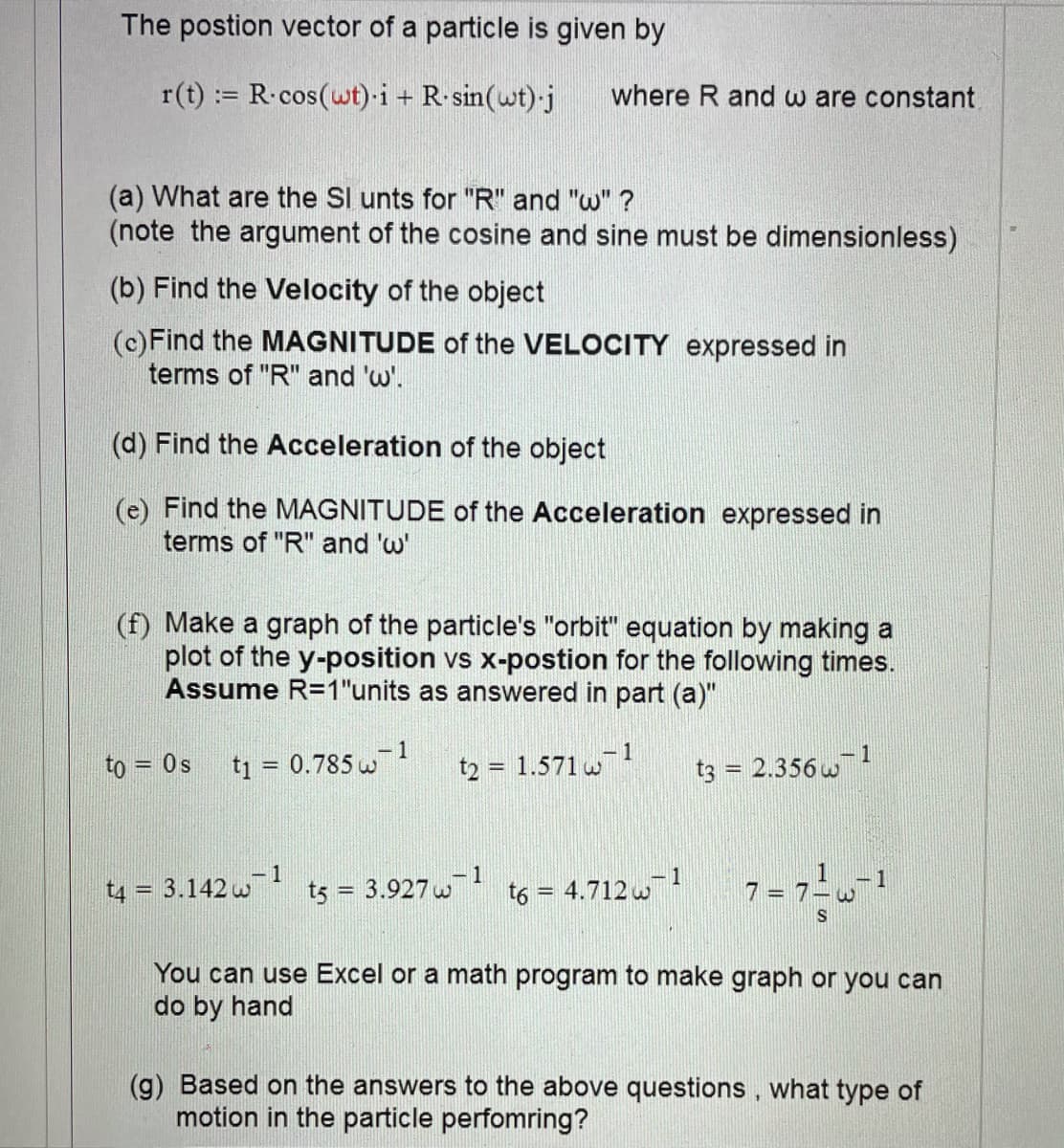r(t) := R-cos(wt)-i + R-sin(wt)-j where R and w are constant (a) What are the Sl unts for "R" and "w" ? (note the argument of the cosine and sine must be dimensionless) (b) Find the Velocity of the object (c)Find the MAGNITUDE of the VELOCITY expressed in terms of "R" and 'w'. (d) Find the Acceleration of the object (e) Find the MAGNITUDE of the Acceleration expressed in terms of "R" and 'w' (f) Make a graph of the particle's "orbit" equation by making a plot of the y-position vs x-postion for the following times. Assume R=1"units as answered in part (a)" to = Os ti -1 0.785 w -1 t2 = 1.571 w 1 t3 = 2.356w %3D 1 -1 t6 = 4.712 w 1 t4 = 3.142 w t5 = 3.927w1 7 = 7-w You can use Excel or a math program to make graph or you can do by hand (g) Based on the answers to the above questions, what type of motion in the particle perfomring?
r(t) := R-cos(wt)-i + R-sin(wt)-j where R and w are constant (a) What are the Sl unts for "R" and "w" ? (note the argument of the cosine and sine must be dimensionless) (b) Find the Velocity of the object (c)Find the MAGNITUDE of the VELOCITY expressed in terms of "R" and 'w'. (d) Find the Acceleration of the object (e) Find the MAGNITUDE of the Acceleration expressed in terms of "R" and 'w' (f) Make a graph of the particle's "orbit" equation by making a plot of the y-position vs x-postion for the following times. Assume R=1"units as answered in part (a)" to = Os ti -1 0.785 w -1 t2 = 1.571 w 1 t3 = 2.356w %3D 1 -1 t6 = 4.712 w 1 t4 = 3.142 w t5 = 3.927w1 7 = 7-w You can use Excel or a math program to make graph or you can do by hand (g) Based on the answers to the above questions, what type of motion in the particle perfomring?
University Physics Volume 1
18th Edition
ISBN:9781938168277
Author:William Moebs, Samuel J. Ling, Jeff Sanny
Publisher:William Moebs, Samuel J. Ling, Jeff Sanny
Chapter2: Vectors
Section: Chapter Questions
Problem 2.10CYU: Check Your Understanding Verify that vector v V obtained in Example 2.14 is indeed a unit vector by...
Related questions
Question
Please show detailed work

Transcribed Image Text:The postion vector of a particle is given by
r(t) := R.cos(wt) i + R sin(wt)-j
where R and w are constant,
(a) What are the SI unts for "R" and "w" ?
(note the argument of the cosine and sine must be dimensionless)
(b) Find the Velocity of the object
(c)Find the MAGNITUDE of the VELOCITY expressed in
terms of "R" and 'w'.
(d) Find the Acceleration of the object
(e) Find the MAGNITUDE of the Acceleration expressed in
terms of "R" and 'w'
(f) Make a graph of the particle's "orbit" equation by making a
plot of the y-position vs x-postion for the following times.
Assume R=1"units as answered in part (a)"
1
t2 = 1.571 w
- 1
to = 0s
ti = 0.785 w
t3 = 2.356 w
-1
1
1
t4 = 3.142 w
t5 = 3.927 w
t6 = 4.712 w
You can use Excel or a math program to make graph or you can
do by hand
(g) Based on the answers to the above questions, what type of
motion in the particle perfomring?
Expert Solution
This question has been solved!
Explore an expertly crafted, step-by-step solution for a thorough understanding of key concepts.
This is a popular solution!
Trending now
This is a popular solution!
Step by step
Solved in 2 steps with 2 images

Knowledge Booster
Learn more about
Need a deep-dive on the concept behind this application? Look no further. Learn more about this topic, physics and related others by exploring similar questions and additional content below.Recommended textbooks for you

University Physics Volume 1
Physics
ISBN:
9781938168277
Author:
William Moebs, Samuel J. Ling, Jeff Sanny
Publisher:
OpenStax - Rice University

Principles of Physics: A Calculus-Based Text
Physics
ISBN:
9781133104261
Author:
Raymond A. Serway, John W. Jewett
Publisher:
Cengage Learning

University Physics Volume 1
Physics
ISBN:
9781938168277
Author:
William Moebs, Samuel J. Ling, Jeff Sanny
Publisher:
OpenStax - Rice University

Principles of Physics: A Calculus-Based Text
Physics
ISBN:
9781133104261
Author:
Raymond A. Serway, John W. Jewett
Publisher:
Cengage Learning